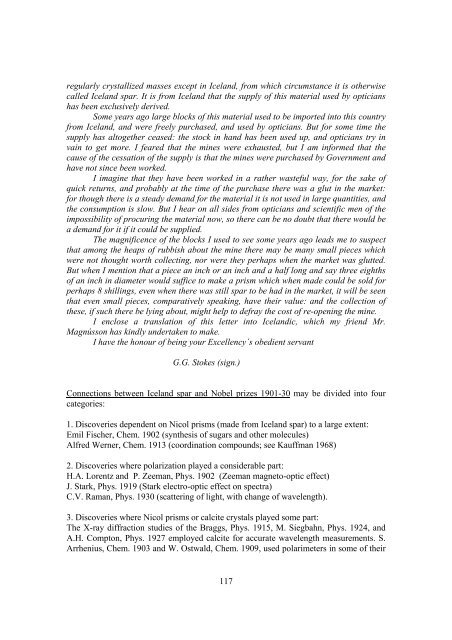Annotated list of references on Iceland spar and polarized light
Annotated list of references on Iceland spar and polarized light Annotated list of references on Iceland spar and polarized light
-1936 Pollard, ?U.K. Usually, Nicol´s prisms are much smaller than this [i.e. 4” aperture] and even moderately sized optically perfect crystals
egularly crystallized masses except in Iceland, from which circumstance it is otherwise called Iceland spar. It is from Iceland that the supply
- Page 65 and 66: • Lowry T.M. and M.A. Vernon (192
- Page 67 and 68: • Malus E.L. (1807b) Mémoire sur
- Page 69 and 70: • Maxwell J.C. (1856) On the uneq
- Page 71 and 72: • Milligan L.H. (1927) Abrasives
- Page 73 and 74: • Murphy D.W. (1897) Spectral pho
- Page 75 and 76: • Nordmann C. (1909b) Méthode pe
- Page 77 and 78: Ann. Chim. 24, 442-459, 31, 67-102
- Page 79 and 80: • Pickering E.C., A. Searle and O
- Page 81 and 82: • Pozzi-Escot M.-E. (1900) Sur un
- Page 83 and 84: 375-384. (An 1890 paper in Danish b
- Page 85 and 86: • Rollett A. (1881) Ueber ein Pol
- Page 87 and 88: • Sagnac G. (1904) Vérifications
- Page 89 and 90: • Schmidt K.E.F. (1888) Ueber die
- Page 91 and 92: polarisée. Ann. Chim. 73, 337-363.
- Page 93 and 94: • Smoluchowski M. (1916) Experime
- Page 95 and 96: • Stauffer L.H. (1930) Electro-op
- Page 97 and 98: • Sutton H. (1890) Le problème d
- Page 99 and 100: • Toennies G. and T.F. Lavine (19
- Page 101 and 102: • Valasek J. (1922) Properties <s
- Page 103 and 104: • Waesche H.H. (1960) Quartz crys
- Page 105 and 106: • Wendell O.C. (1909) Photometric
- Page 107 and 108: • Wilhelmy L. (1850) Ueber das Ge
- Page 109 and 110: • Wright F.E. (1908) The bi-quart
- Page 111 and 112: Berge Foros und die ersten russisch
- Page 113 and 114: -About 1895, B. Halle catalog, D…
- Page 115: -1921 Halle, D., describes his meth
- Page 119: H. Kamerlingh Onnes, Phys. 1913, pr
egularly crystallized masses except in <strong>Icel<strong>and</strong></strong>, from which circumstance it is otherwise<br />
called <strong>Icel<strong>and</strong></strong> <strong>spar</strong>. It is from <strong>Icel<strong>and</strong></strong> that the supply <str<strong>on</strong>g>of</str<strong>on</strong>g> this material used by opticians<br />
has been exclusively derived.<br />
Some years ago large blocks <str<strong>on</strong>g>of</str<strong>on</strong>g> this material used to be imported into this country<br />
from <strong>Icel<strong>and</strong></strong>, <strong>and</strong> were freely purchased, <strong>and</strong> used by opticians. But for some time the<br />
supply has altogether ceased: the stock in h<strong>and</strong> has been used up, <strong>and</strong> opticians try in<br />
vain to get more. I feared that the mines were exhausted, but I am informed that the<br />
cause <str<strong>on</strong>g>of</str<strong>on</strong>g> the cessati<strong>on</strong> <str<strong>on</strong>g>of</str<strong>on</strong>g> the supply is that the mines were purchased by Government <strong>and</strong><br />
have not since been worked.<br />
I imagine that they have been worked in a rather wasteful way, for the sake <str<strong>on</strong>g>of</str<strong>on</strong>g><br />
quick returns, <strong>and</strong> probably at the time <str<strong>on</strong>g>of</str<strong>on</strong>g> the purchase there was a glut in the market:<br />
for though there is a steady dem<strong>and</strong> for the material it is not used in large quantities, <strong>and</strong><br />
the c<strong>on</strong>sumpti<strong>on</strong> is slow. But I hear <strong>on</strong> all sides from opticians <strong>and</strong> scientific men <str<strong>on</strong>g>of</str<strong>on</strong>g> the<br />
impossibility <str<strong>on</strong>g>of</str<strong>on</strong>g> procuring the material now, so there can be no doubt that there would be<br />
a dem<strong>and</strong> for it if it could be supplied.<br />
The magnificence <str<strong>on</strong>g>of</str<strong>on</strong>g> the blocks I used to see some years ago leads me to suspect<br />
that am<strong>on</strong>g the heaps <str<strong>on</strong>g>of</str<strong>on</strong>g> rubbish about the mine there may be many small pieces which<br />
were not thought worth collecting, nor were they perhaps when the market was glutted.<br />
But when I menti<strong>on</strong> that a piece an inch or an inch <strong>and</strong> a half l<strong>on</strong>g <strong>and</strong> say three eighths<br />
<str<strong>on</strong>g>of</str<strong>on</strong>g> an inch in diameter would suffice to make a prism which when made could be sold for<br />
perhaps 8 shillings, even when there was still <strong>spar</strong> to be had in the market, it will be seen<br />
that even small pieces, comparatively speaking, have their value: <strong>and</strong> the collecti<strong>on</strong> <str<strong>on</strong>g>of</str<strong>on</strong>g><br />
these, if such there be lying about, might help to defray the cost <str<strong>on</strong>g>of</str<strong>on</strong>g> re-opening the mine.<br />
I enclose a translati<strong>on</strong> <str<strong>on</strong>g>of</str<strong>on</strong>g> this letter into <strong>Icel<strong>and</strong></strong>ic, which my friend Mr.<br />
Magnúss<strong>on</strong> has kindly undertaken to make.<br />
I have the h<strong>on</strong>our <str<strong>on</strong>g>of</str<strong>on</strong>g> being your Excellency´s obedient servant<br />
G.G. Stokes (sign.)<br />
C<strong>on</strong>necti<strong>on</strong>s between <strong>Icel<strong>and</strong></strong> <strong>spar</strong> <strong>and</strong> Nobel prizes 1901-30 may be divided into four<br />
categories:<br />
1. Discoveries dependent <strong>on</strong> Nicol prisms (made from <strong>Icel<strong>and</strong></strong> <strong>spar</strong>) to a large extent:<br />
Emil Fischer, Chem. 1902 (synthesis <str<strong>on</strong>g>of</str<strong>on</strong>g> sugars <strong>and</strong> other molecules)<br />
Alfred Werner, Chem. 1913 (coordinati<strong>on</strong> compounds; see Kauffman 1968)<br />
2. Discoveries where polarizati<strong>on</strong> played a c<strong>on</strong>siderable part:<br />
H.A. Lorentz <strong>and</strong> P. Zeeman, Phys. 1902 (Zeeman magneto-optic effect)<br />
J. Stark, Phys. 1919 (Stark electro-optic effect <strong>on</strong> spectra)<br />
C.V. Raman, Phys. 1930 (scattering <str<strong>on</strong>g>of</str<strong>on</strong>g> <strong>light</strong>, with change <str<strong>on</strong>g>of</str<strong>on</strong>g> wavelength).<br />
3. Discoveries where Nicol prisms or calcite crystals played some part:<br />
The X-ray diffracti<strong>on</strong> studies <str<strong>on</strong>g>of</str<strong>on</strong>g> the Braggs, Phys. 1915, M. Siegbahn, Phys. 1924, <strong>and</strong><br />
A.H. Compt<strong>on</strong>, Phys. 1927 employed calcite for accurate wavelength measurements. S.<br />
Arrhenius, Chem. 1903 <strong>and</strong> W. Ostwald, Chem. 1909, used polarimeters in some <str<strong>on</strong>g>of</str<strong>on</strong>g> their<br />
117



